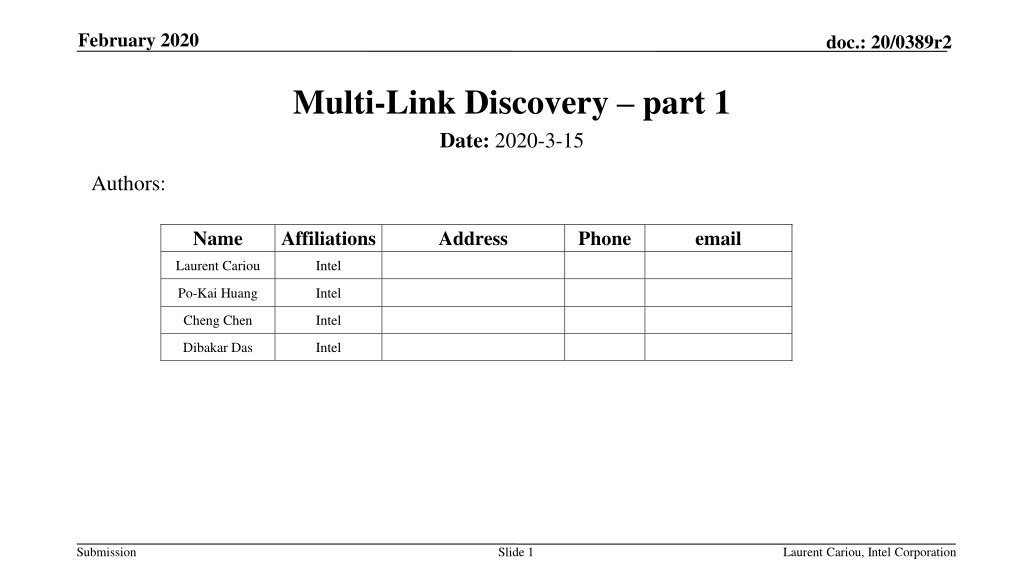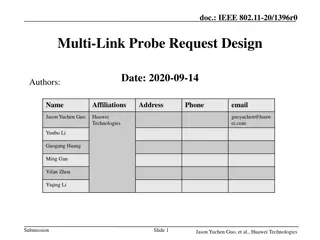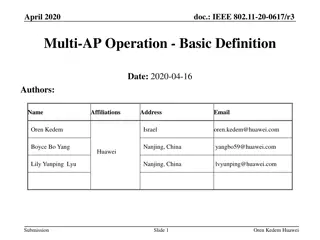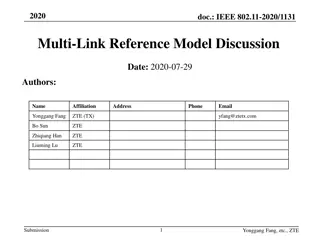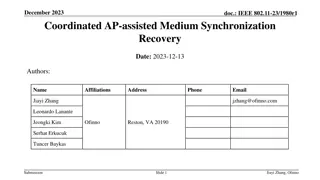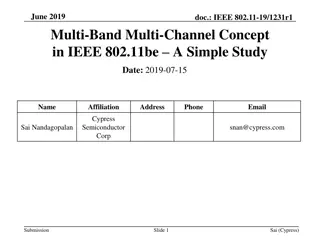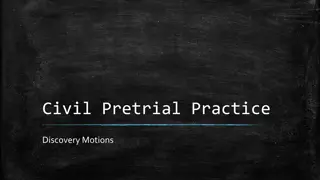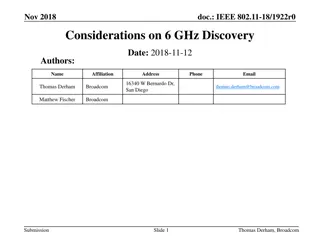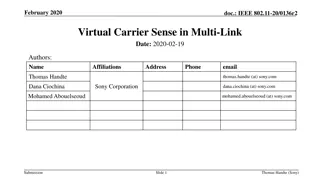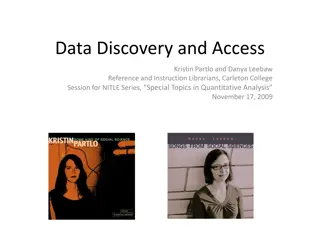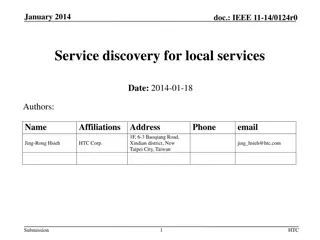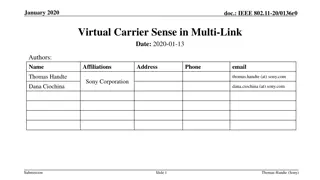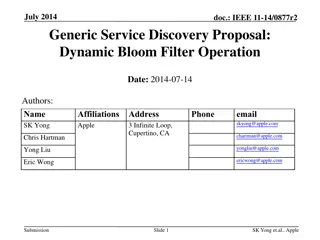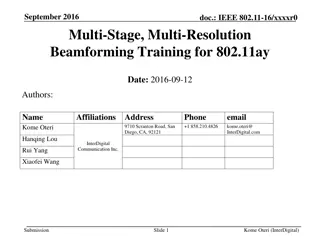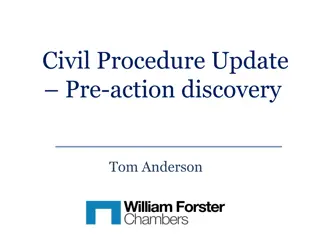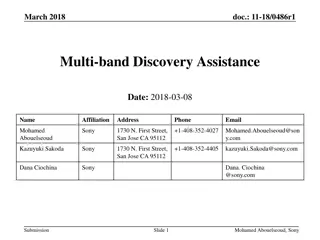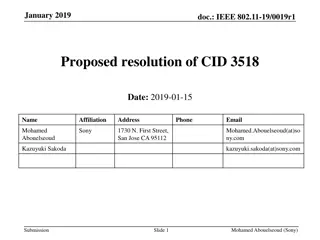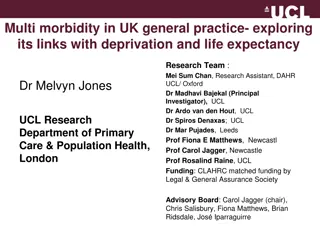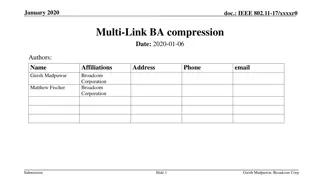Multi-Link Discovery in February 2020
In February 2020, the document discusses the process of multi-link discovery, focusing on two distinct scenarios for discovering access points (APs). It delves into the definitions of basic and complete information and outlines the methods for basic discovery through listening to beacons or probe responses. The document emphasizes the importance of providing essential information about the AP MLD (Multi-Link Discovery) and suggests minimal mandatory information to include, considering the bloat in beacons if all information is incorporated.
Download Presentation

Please find below an Image/Link to download the presentation.
The content on the website is provided AS IS for your information and personal use only. It may not be sold, licensed, or shared on other websites without obtaining consent from the author.If you encounter any issues during the download, it is possible that the publisher has removed the file from their server.
You are allowed to download the files provided on this website for personal or commercial use, subject to the condition that they are used lawfully. All files are the property of their respective owners.
The content on the website is provided AS IS for your information and personal use only. It may not be sold, licensed, or shared on other websites without obtaining consent from the author.
E N D
Presentation Transcript
February 2020 doc.: 20/0389r2 Multi-Link Discovery part 1 Date: 2020-3-15 Authors: Name Affiliations Address Phone email Laurent Cariou Intel Po-Kai Huang Intel Cheng Chen Intel Dibakar Das Intel Submission Slide 1 Laurent Cariou, Intel Corporation
February 2020 doc.: 20/0389r2 Objectives Before being able to do multi-link setup with an AP MLD, a non-AP MLD has to discover the AP MLD. We focus on 2 different discovery scenarios: Discover basic information (full scan): discover APs around, evaluate what would be the closest AP Discover all information right before doing multi-link setup We focus on the information that is carried in beacons and probe responses Submission Slide 2 Laurent Cariou, Intel Corporation
February 2020 doc.: 20/0389r2 Definitions Basic information: only a subset of information that describe a reported AP Complete information: all the elements that are currently included in beacons/probe responses that describe the reporting AP Submission Slide 3 Laurent Cariou, Intel Corporation
February 2020 doc.: 20/0389r2 Basic discovery (1/2) Basic discovery is done by listening to beacons or probe responses (unsolicited, ) or sending probes We propose that each AP of an AP MLD provides basic information about the AP MLD (about other APs affiliated with the MLD) Not all the information (capabilities, operation elements, ) need to be included in each beacons, as this would bloat the beacons (as each AP may have different capabilities ): we need to define what is the minimum mandatory information to carry We can also of course define ways to optionally include more information Most APs that are part of an MLD will also be 11ax APs and will already be mandated to include RNR describing all the other co-located APs (requirement in 11ax): Including Operating Class/Channel, BSSID, Short SSID, TBTT offset, BSS parameters RNR has been designed to be forward compatible 11ax devices read a TBTT Info field of length higher than 12 as follows: Treat first 12 Bytes as if TBTT Info field length is 12 Ignore the remaining Bytes Submission Slide 4 Laurent Cariou, Intel Corporation
February 2020 doc.: 20/0389r2 Basic discovery (2/2) We propose to mandate the following: all APs that are part of the same MLD as the reporting AP and that are collocated with the reporting AP shall be reported in the RNR element in beacons and broadcast probe responses transmitted by the reporting AP Note: non-collocated APs may also be reported We propose to also include in the RNR: At least an indication that the reported AP is part of the same MLD as the reporting AP Submission Slide 5 Laurent Cariou, Intel Corporation
February 2020 doc.: 20/0389r2 RNR with multiple BSSID We agreed in 11ax that in case of multiple BSSID set, the RNR is not included in the non-transmitted BSSID profile of the multiple BSSID element, but in the core of the beacon There is therefore only one RNR, and it includes all the reported APs In our example: multiple BSSID set of 3 APs (3 SSIDs), and each AP is part of an MLD on 3 links (2.4/5/6 GHz) The RNR sent by one AP in its beacon therefore has to report all 6 collocated APs (all collocated APs from same MLD for all APs in the multiple BSSID set We therefore need a way in the RNR to identify which reported APs is in which MLD Field to include that it is part of the same MLD as the reporting AP is not sufficient here We propose to include the BSSID-index in the TBTT Info field of a reported AP Submission Slide 6 Laurent Cariou, Intel Corporation
February 2020 doc.: 20/0389r2 Probing before multi-link setup Following current behaviors, non-AP MLDs will want to have the complete information on an AP MLD (on each APs of the AP MLD) before doing multi-link setup As beacons/probe responses from each AP will provide mainly their complete information, and only the basic information for the other APs of the same MLD, a non-AP MLD will have to go and scan all the APs of the MLD before doing multi-link setup We believe that it would be very beneficial to define a way for a STA to collect the complete information for all the APs (at least the co-located ones) of a particular MLD from one of the APs of the AP MLD Submission Slide 7 Laurent Cariou, Intel Corporation
February 2020 doc.: 20/0389r2 Straw polls SP1 Do you agree that all APs that are part of the same MLD as a reporting AP and that are collocated with the reporting AP shall be reported in the RNR element that is included in the beacons and the broadcast probe responses transmitted by the reporting AP Do you agree that all APs that are part of the same MLD as a non-transmitted BSSID and that are collocated with the non-transmitted BSSID shall be reported in the RNR element that is included in the beacons and the broadcast probe responses transmitted by the transmitted BSSID that is in the same Multiple BSSID set as the non-transmitted BSSID Note: an AP is not included if it is not discoverable Note: RNR provides basic information (operating class, channel, BSSID, short SSID, ) Note: 11ax rules also apply, and any AP in other AP MLDs can optionally be reported Submission Slide 8 Laurent Cariou, Intel Corporation
February 2020 doc.: 20/0389r2 Straw polls SP2 Do you agree: to include in a TBTT Information field of the RNR, corresponding to a reported AP that is part of the same MLD as the reporting AP, an indication that the reported AP is part of the same MLD as the reporting AP when the reporting AP is either not part of a multiple BSSID set or corresponds to a transmitted BSSID in a multiple BSSID set to include in a TBTT Information field of the RNR, corresponding to a reported AP that is part of the same MLD as a non-transmitted BSSID, an indication that the reported AP is part of the same MLD as the non-transmitted BSSID, if the RNR is carried in a frame transmitted by the transmitted BSSID that is in the same Multiple BSSID set as the non-transmitted BSSID Note: signaling of that indication is TBD Submission Slide 9 Laurent Cariou, Intel Corporation
February 2020 doc.: 20/0389r2 Straw polls SP3 Do you agree to include in the TBTT Information field of the RNR the BSSID-index of the reported AP, if the reported AP is part of the same MLD as an AP from the same multiple BSSID set as the reporting AP? Submission Slide 10 Laurent Cariou, Intel Corporation
February 2020 doc.: 20/0389r2 Probing proposal We propose to include a specific request for MLD response in a probe request frame sent to one AP of an AP MLD For instance: a new MLD request element Request to include all collocated APs, all APs, or a list of APs In response to that, the AP will include in the probe response the complete information for all the requested APs Need a way to include in the probe response the complete information for other APs Timestamp or TBTT offset? (surely optional for non-collocated) If the group prefers, we can define a new frame exchange, but the simplest seems to be to use the probe request/response frames Submission Slide 11 Laurent Cariou, Intel Corporation
February 2020 doc.: 20/0389r2 Straw polls SP4 Do you agree to define a mechanism for a STA of a non-AP MLD to send a probe request frame to an AP belonging to an AP MLD, that enables to request a probe response from the AP that includes the complete set of capabilities, parameters and operation elements of other APs affiliated to the same MLD as the AP The complete information is defined as all elements that would be provided if the reported AP was transmitting that same frame (exceptions TBD) It s TBD if the AP is mandated or not to respond with the requested information Submission Slide 12 Laurent Cariou, Intel Corporation
